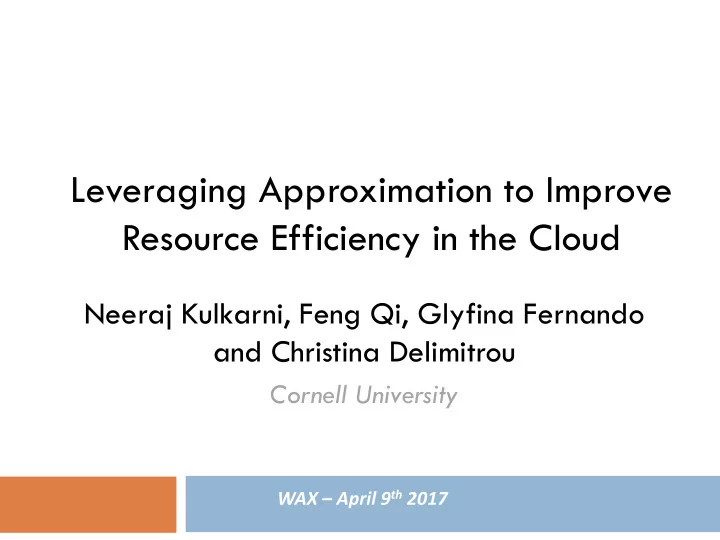

SAIL (Systems, Architecture and Infrastructure Lab) Leveraging Approximation to Improve I MPROVING R ESOURCE E FFICIENCY Resource Efficiency in the Cloud I N C LOUD C OMPUTING Neeraj Kulkarni, Feng Qi, Glyfina Fernando Christina Delimitrou and Christina Delimitrou Cornell University Cornell University WAX – April 9 th 2017
Datacenter Underutilization Twitter (Mesos) 1 Google (Borg) 2 4-5x 3-5x 0 10 20 30 40 50 60 70 80 90 100 CPU Utilization (%) 1 C. Delimitrou and C. Kozyrakis. Quasar: Resource-Efficient and QoS-Aware Cluster Management, ASPLOS 2014. 2 L. A. Barroso, U. Holzle. The Datacenter as a Computer, 2013. 2
A Common Approach App1 App2 Co-schedule multiple cloud services on same physical platform Often leads to resource interference, especially when sharing cores 3
A Common Cure App1 App2 Co-schedule one high priority and one/more best-effort apps Performance is non-critical for best effort jobs Disadvantage: assume best-effort apps are always low priority 4
Approximate Computing Apps to the Rescue App1 App2 Approximate computing apps can absorb a loss of resources as loss of output quality instead of a loss in performance Advantage: performance of all co-scheduled applications is high- priority 5
Pliant Pliant runtime App1 App2 Enables latency-critical & approximate apps to share resources (including cores) without penalizing their performance Tunes degree and type of approximation based on measured 6 interference
Challenges Identify opportunities for approximation 1. Pliant runtime ACCEPT (precision, loop perforation, sync elision), algorithmic exploration App1 App2 Lightweight profiling to determine when to 2. employ approximation End-to-end latency/throughput & perf counters Determine what resource(s) to constrain? 3. Based on measured interference Determine what type of approximation & to 4. what extent? Based on interference and performance impact 7
Pliant Server Pliant runtime Interference Client monitor Workload generator App1 App2 Performance monitor DynamoRIO for switching between precise/approximate versions Initial implementation, overheads high but not prohibitive Looking into Petabricks and LLVM 8
Adaptive Approximation Incremental approximation: Employ the minimum amount of approximation (quality loss) to restore the performance of the interactive service Several versions for each type of approximation, choose online Interference-aware approximation: Choose the type of interference that minimizes pressure in the bottlenecked resource Example: High memory interference prioritize algo tuning High CPU interference prioritize sync elision, loop perforation 9
Methodology Latency-critical interactive services: memcached & nginx Open-loop workload generator & performance monitor Facebook traffic pattern Approximate computing apps: PARSEC, SPLASH, Spark MLlib System: 2 2-socket, 40-core servers, 128GB RAM each 10
Evaluation memcached sharing physical cores with PARSEC Latency Degree of approximation 11
Conclusions Approximate computing: opportunity to improve cloud efficiency without loss in performance Pliant: cloud runtime to co-schedule interactive services with approximate computing apps Incremental and interference-aware approximation Preserves QoS for interactive service with minimal loss in quality for approximate computing application Current work: DynamoRIO Petabricks/LLVM Add cloud approximate computing application Improve interference awareness Leverage hardware isolation techniques 12
Questions? Approximate computing: opportunity to improve cloud efficiency without loss in performance Pliant: cloud runtime to co-schedule interactive services with approximate computing apps Incremental and interference-aware approximation Preserves QoS for interactive service with minimal loss in quality for approximate computing application Current work: DynamoRIO Petabricks/LLVM Add cloud approximate computing application Improve interference awareness Leverage hardware isolation techniques 13
Recommend
More recommend